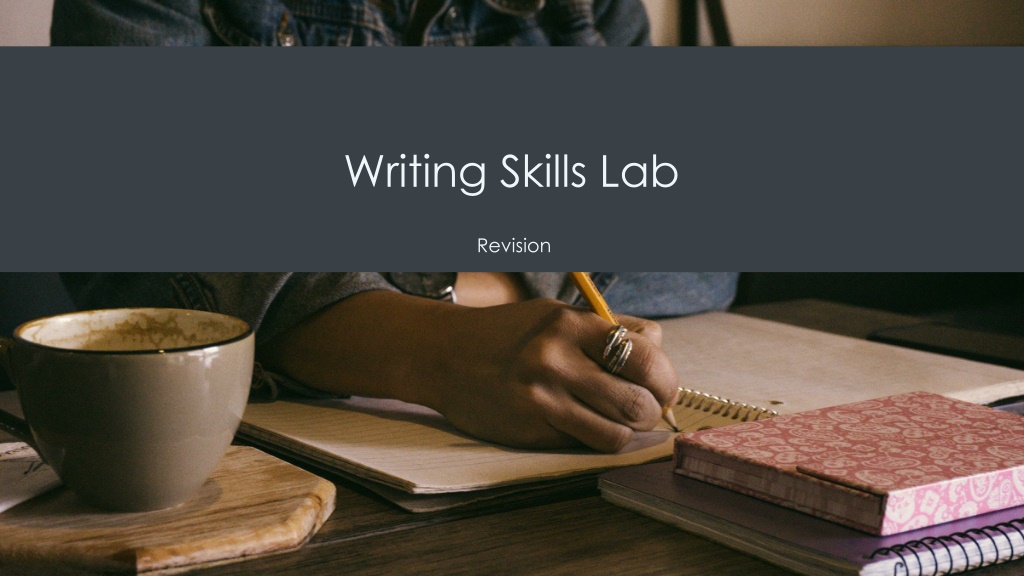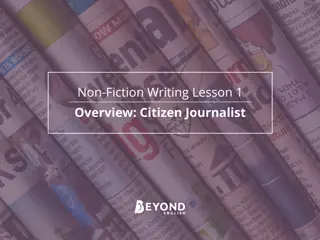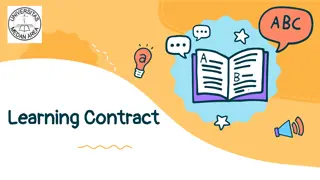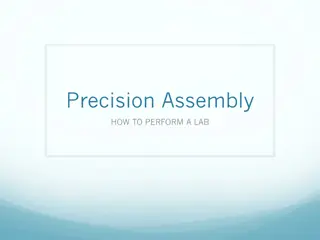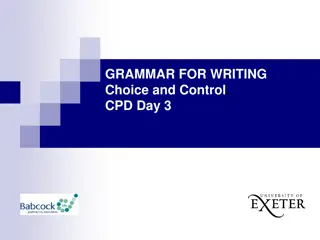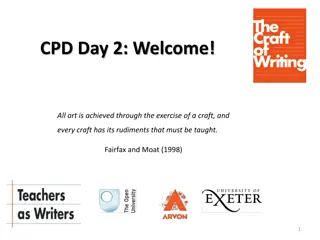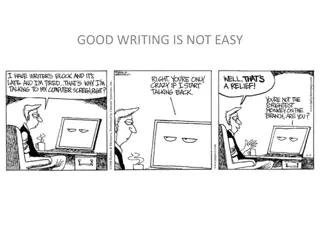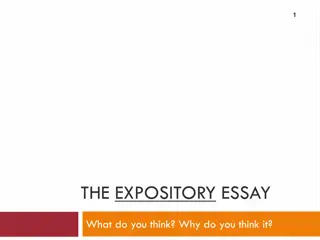Writing Skills Lab
Planning for future financial goals requires understanding how to calculate the present value of investments. This involves determining the amount you need to invest now to reach a specific financial target. By considering factors such as interest rates, time, and the desired future amount, you can effectively plan for upcoming expenses or goals. Explore examples of calculating the present value of single deposit and periodic deposit investments to gain insights into saving strategies.
Download Presentation

Please find below an Image/Link to download the presentation.
The content on the website is provided AS IS for your information and personal use only. It may not be sold, licensed, or shared on other websites without obtaining consent from the author.If you encounter any issues during the download, it is possible that the publisher has removed the file from their server.
You are allowed to download the files provided on this website for personal or commercial use, subject to the condition that they are used lawfully. All files are the property of their respective owners.
The content on the website is provided AS IS for your information and personal use only. It may not be sold, licensed, or shared on other websites without obtaining consent from the author.
E N D
Presentation Transcript
Writing Skills Lab Revision
Learning Outcomes Identify strategies for revising for content Recognize rhetorical context in relation to content Identify strategies for development Identify the strategies for revising for structure Recognize rhetorical context in relation to structure Identify strategies for revising for paragraph structure Identify strategies for revising for global structure Evaluate strategies for arranging ideas Identify strategies for revising for style Recognize rhetorical context in relation to style Identify strategies for revising for style Evaluate strategies for revising for style Identify strategies for revising for grammar and mechanics Recognize common grammar and mechanical errors Demonstrate ability to proofread
Revision Revision leads to better thinking, as writers challenge their own ideas, weigh the evidence they have included, and scrutinize their own logic. Revision leads to better writing, as writers reflect on their composing practices, learn to identify their strengths, and find ways to overcome their weaknesses. Revision leads to better outcomes, as readers recognize writing that has been carefully considered and re-considered. That recognition brings higher regard from readers and, when those readers are professors, often leads to higher grades.
Rhetorical Context and Purpose If your purpose is not clear, your audience is not likely to receive your intended message. Making sure your purpose is clear can help identify areas needing revision or areas for further exploration. Clearly defining your purpose before you begin writing, it s less likely you ll be that author who leaves the audience wondering.
Rhetorical Context and Audience When analyzing your audience, consider these points. Doing this should make it easier to create a profile of your audience, which can help guide your writing choices. What to think about: Background Knowledge Expectations and Interests Attitudes and Biases Demographics
Working with Your Draft You may find yourself with a draft that is incomplete. Sometimes this means that you haven t reached the word or page expectations of the assignment, but more importantly, it means that there are areas of weakness in the draft some ideas are not fully explored. Use strategies that can help with expanding and clarifying ideas. Remember that purpose and audience are key factors in recognizing these places. Take note of facts, judgments, testimony, and personal observation.
Activity: Hotspotting Read through your draft marking sentences that convey important ideas in your paper. These are areas where your writing and thinking is significant or hot. Copy one of the hot sentences into a new document. Use that sentence as the first sentence of a new paragraph. Write for 10 or 15 minutes. Don t worry if you seem to be moving in a different direction from your original draft; you might be on to new and better material. When time is up compare the new material with your original draft. Could the new material be incorporated into or substituted for the original? Could the new material be the start of a new part of the original draft? Repeat with other hot sentences.
Working With Peers Talk it out: Find some peers and have a conversation about your piece of writing. Have a conversation where you tell them your ideas and verbalize each of your points. If possible, record your conversation. What I really mean is: Ask a friend to read through your draft, and mark places where difficult or complicated ideas don t seem to be coming through clearly. Then, look at each passage and explain to your friend what you meant to say in that passage, and ask your friend to write down what you are saying. Sometimes verbally articulating an idea helps to clarify it.
Global Structure Revising for structure goes far beyond just making sure you have an introduction, body, and conclusion to an essay. When you revise for structure, you want to consider how well all the parts of the essay work together and whether the order of ideas makes sense. Does necessary background information come first? Is there a clear connection between evidence and your commentary on that evidence? Does all the necessary evidence appear in the body of the essay?
Global Structure (continued) Write stronger introductions both for the whole document and for major sections Look for a stronger thesis in the conclusion of the essay draft Consider audience receptiveness Cut up your essay Create a reverse outline
Rhetorical Context and Structure Just like revising for content, revising for structure requires you to think about purpose and audience. Writing an email to your professor asking for an appointment Filling out a Student of Concern form Composing an About Me page for a professional blog
Paragraph Structure Most formal writing will require you to organize information in paragraphs. There are many strategies for composing paragraphs, but most boil down to a similar formula that includes a key sentence, evidence, and author commentary on that evidence. If you already have these elements in a paragraph, you ll want to focus on the organization of ideas within a paragraph. Creating a reverse micro outline or cutting up the sentences of an individual paragraph, along with strengthening transitions within a paragraph, can help you as you revise for paragraph structure.
Rhetorical Context and Style Style is the way writing is dressed up (or down) to fit the specific context, purpose, or audience. Word choice, sentence variety, and the writer s voice all contribute to the style of a piece of writing. How a writer chooses words and structures sentences to achieve a certain effect is also an element of style. Style is not a matter of right and wrong but of what is appropriate for a particular setting and audience.
Revising for Style: Word Choice Good writers are concise and precise, weeding out unnecessary words and choosing the exact word to convey meaning. Precise words active verbs, concrete nouns, specific adjectives help the reader visualize the sentence. Good writers use adjectives sparingly and adverbs rarely, letting their nouns and verbs do the work. Avoid slang Avoid language that is overly casual Avoid clich s Be careful when you use words that sound alike but have different meanings Choose words with the connotations you want Use specific words rather than overly general words
Revising for Style: Choose words that are sensitive to your audience As you revise for style, look closely at the language you have used in your drafts. Often, we write words that are fairly common but might be offensive to some readers or make them feel like they are excluded from being valuable members of your audience. Revision is a chance to think carefully about your language choices and to make sure you are considering all potential readers. Gender Terms Racial or ethnic terms Terms for people with disabilities
Revising For Style: Wordiness Sometimes writers use too many words when fewer words will appeal more to their audience and better suite their purpose. Eliminating wordiness helps all readers because it makes your ideas clear, direct, and straightforward. Watch out for: Sentences that begin with There is or There are Sentences with unnecessary modifiers Sentences with unnecessary phrases that add little to the meaning
Revising for Style: Voice Active Voice: Readers prefer sentences constructed with the active voice because they are more concise and direct. Consider the following revisions: Passive Voice: Sometimes the passive voice will cover up important information in a sentence. When is the passive voice useful?
Introduction to Revising for Grammar and Mechanics
Obvious Punctuation Errors Writers do themselves a great favor by learning to understand punctuation conceptually and fundamentally, as follows: A comma is a separator. A colon is an arrow pointing forward. It tells the reader that new information, which is promised by the wording before it, is about to arrive. A semicolon is a mark of co-dependency. A dash redefines what was just said.
Adopt A Listening Ear The key to revising your work for grammar (both word choice and wording) and mechanics (small but important matters such as punctuation) is to listen to your work anew. The best writers adopt an objective listening ear, learning to detect their problems of grammar and mechanics both intuitively and methodically, pretending they re encountering the work for the first time no matter how many times they ve re-read it.
Practice Question What are some strategies you use to proofread your papers?
Quick Review: Putting It Together: Revision Now that you have learned to recognize strategies for revision, make them an integral part of your writing process. For every writing project, budget time to consider the following: Content: Does the content of this project fulfill the purpose of the assignment? Will the audience be persuaded by the ideas and evidence? What strategies could I use to improve the content? Structure: Is the organization of the project appropriate for the purpose of the assignment? Will the audience find the project well-organized and logical? What strategies might I use to improve the structure? Style: Does the style of the project align with the purpose of the assignment? Will the audience recognize the style as appropriate and effective? What strategies might I use to improve the style? Grammar and mechanics: Will readers be hindered and irritated by errors in grammar and mechanics? Will errors in grammar and mechanics damage my ethos as a writer? What strategies might I use to edit and proofread the project?
